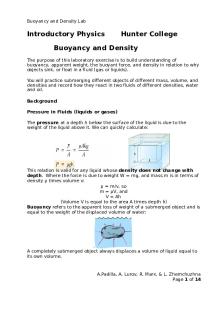Lab Report 10 Emily Travis PDF

| Title | Lab Report 10 Emily Travis |
|---|---|
| Author | Emily Travis |
| Course | Elements of Physics |
| Institution | The University of Tennessee |
| Pages | 4 |
| File Size | 141.8 KB |
| File Type | |
| Total Downloads | 20 |
| Total Views | 128 |
Summary
lab report 10...
Description
Name: Emily Travis E-mail address: [email protected] Laboratory 10 Report Purpose: The purpose of this lab is to study both the particle and wave like nature of electrons by observing and analyzing electron diffraction. Experiment 1 a) Exploration: For a Sodium target discuss: For a fixed number of photons and zero battery voltage, how does the number of photoelectrons ejected depend on the wavelength? Does every photon eject an electron? Does the probability of ejection change with wavelength? Discuss! The higher the wavelength, the less electrons are ejected. However, higher wavelengths send more photons to the plate so no, not every photon ejects an electron. The lower the wavelength, the more electrons are ejected but they are not proportionate with each other. For a fixed wavelength and zero battery voltage, how does the current depend on the light intensity? Discuss! An increased intensity of wavelength does impact the current by raising it. However, not all wavelengths will create a current, even at 100% intensity. For a fixed wavelength and light intensity, how does the current depend on the battery voltage? A change in battery voltage only affects current when the battery voltage is negative. For a fixed wavelength and light intensity, do all ejected electrons have the same energy? How can you measure the maximum energy of the ejected electrons. No, not all ejected electrons have the same energy. The maximum energy of those electrons can be measured by determining which voltage level will bring the current of the wire to zero. That is the maximum energy of electrons at that fixed wavelength and light intensity.
b) Measurement: Wavelength (nm)
Frequency (s-1)
Maximum Electron Energy (eV)
150
2.00e15
-6.00
200
1.50e15
-4.00
300
1.00e15
-1.80
400
0.75e15
-0.60
500
0.60e15
-0.20
1.What value did you obtain for h in units of eV s and J s? 4e-18 2.How does this value compare with the accepted value h = 6.626*10−34 J s = 4.136*10−15 eV s? This value is similar to the accepted value for h in eVs 3.Describe how the maximum energy of the photoelectrons depends on the wavelength of the incident light. The maximum electron energy shows an exponential increase along with the wavelength of light. 4.Defend whether this experiment supports a wave or a quantum model of light based on your lab results. This experiment supports a quantum model of light because there is no oscillation occurring
and we are dealing with electrons as particles.
Experiment 2 Make the measurements and fill in the table below. Measure the center-to-center distance for each bright ring.
1st ring (d100)
2nd ring (d110)
d (m)
2.10E-10
1.21E-10
L (m)
0.135
0.135
D (m)
0.074
0.776
z
0.037
0.058
λ = dz/L
5.8e-11
5.2e-11
1.Do the two values for λ agree within experimental uncertainty? They agree with each other but not experimentally. They are not close to being deBroglie’s value for wavelength. 2.What do you think contributes most to the experimental uncertainty? Visual measurement techniques can be off and calculation errors can contribute to error but because we can use sinθ and diameter to determine wavelength. 3.Is your experimental value of λ close to the expected de Broglie wavelength of the electrons? The first rings experimentalƛ was closer to the calculated value of deBroglie’s. The second rings experimental ƛ was higher than deBroglie’s.. 4.Does this experiment convince you that electrons do not behave like classical particles, or can you think of a classical explanation for your results? They don’t behave like classical particles because in the presence of a magnet, electrons change shape and behave with wave-like properties....
Similar Free PDFs

Lab Report 10 Emily Travis
- 4 Pages

Lab Report 9 Emily Travis
- 1 Pages

Emily Travis Lab8 - lab report 8
- 2 Pages

Lab 10 - Lab 10 Report
- 7 Pages

Orgo 2 Lab 10 - Lab Report 10
- 4 Pages

Chem lab 10 - lab report
- 9 Pages

Phys lab 10 - Lab report
- 14 Pages

Post Lab Report 10
- 8 Pages

Lab Report 10
- 8 Pages

Lab Report 10
- 9 Pages

Online Lab Report 10
- 7 Pages

Lab Report 10 survivorship
- 1 Pages

Programming Lab Report 10
- 8 Pages

Experiment 10 Lab Report
- 9 Pages

Emily Prager - Lecture notes 10
- 2 Pages

8 - Travis Stern
- 2 Pages
Popular Institutions
- Tinajero National High School - Annex
- Politeknik Caltex Riau
- Yokohama City University
- SGT University
- University of Al-Qadisiyah
- Divine Word College of Vigan
- Techniek College Rotterdam
- Universidade de Santiago
- Universiti Teknologi MARA Cawangan Johor Kampus Pasir Gudang
- Poltekkes Kemenkes Yogyakarta
- Baguio City National High School
- Colegio san marcos
- preparatoria uno
- Centro de Bachillerato Tecnológico Industrial y de Servicios No. 107
- Dalian Maritime University
- Quang Trung Secondary School
- Colegio Tecnológico en Informática
- Corporación Regional de Educación Superior
- Grupo CEDVA
- Dar Al Uloom University
- Centro de Estudios Preuniversitarios de la Universidad Nacional de Ingeniería
- 上智大学
- Aakash International School, Nuna Majara
- San Felipe Neri Catholic School
- Kang Chiao International School - New Taipei City
- Misamis Occidental National High School
- Institución Educativa Escuela Normal Juan Ladrilleros
- Kolehiyo ng Pantukan
- Batanes State College
- Instituto Continental
- Sekolah Menengah Kejuruan Kesehatan Kaltara (Tarakan)
- Colegio de La Inmaculada Concepcion - Cebu